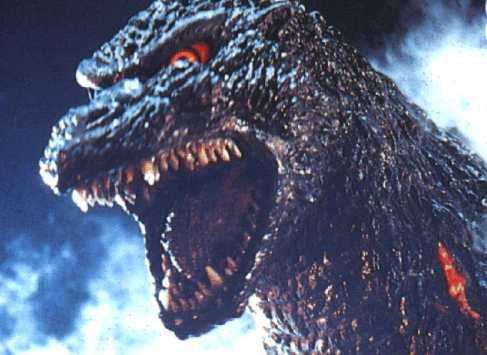Godzilla is a Kaiju or monster appearing first in Ishiro Honda’s 1954 film titled, Godzilla. Research of Godzilla highlighted Godzilla’s role, not only, as a monster, but also, as a symbolization of the relationship between Japan and America. As the relationship between Japan and America changed and developed so did Godzilla. In 1954 Godzilla was first portrayed as an innocent victim of nuclear testing, symbolizing differences between Americans and the Japanese. In the 1964 Film, Godzilla vs. Mothra, Godzilla is transformed into an evil monster. He is then portrayed as being tamed in Ghidrah – The Three Headed Monster in 1965. American occupation in Japan ended around 1958, which would explain the various uses of Godzilla’s symbolism. He is a true example of race and ethnography used to express the feelings and interactions between two countries of differing backgrounds and cultures.
A reoccurring theme for Godzilla was his representation as the “ethnographic other.” Interaction between two foreign and differing cultures can often lead to the perceptions of “otherness”. In this case Western and American culture meets the differing Japanese culture that leads to the perception of “otherness”. Godzilla effectively highlights this otherness between the two countries. Americans perceive Godzilla as the “other” because they cannot identity with the dangerous and intrusive monster, while the Japanese perceive Godzilla as the other because it symbolizes the powerful and foreign American country that threatens their safety with atomic bombs. With both countries having different perceptions and illustrations of Godzilla, Godzilla’s true monstrosity and danger is highlighted and expressed, as he or the “other” is greatly feared by many.
Works Cited
Godzilla. Dir. Roland Emmerich. Perf. Mathew Broderick and Jean Reno. 1998
The 1998 film of Godzilla, directed by Roland Emmerich, depicts Godzilla as a foreigner invading the United States. Beginning in New York, Godzilla, who can produce asexually, becomes a threat to the safety of the country. His ability to rapidly multiply is viewed by some as a symbol of immigrants arriving in the country and spreading their various cultures and ideas. The film helped me in viewing Godzilla as a threat and ethnographic other to Americans.
Lees, J. D., Marc Cerasini, and Alice Alfonsi. The Official Godzilla Compendium. New York: Random House, 1998. Print.
The official Godzilla Compendium is a book that consists of various essays, movie summaries, and photos about Godzilla. The book begins with Godzilla’s original appearance in Godzilla: King of the Monsters, a 1954 film. From there the book travels with Godzilla as he grows, develops and changes over a forty year time period. This highlights how Godzilla changed over time, having various purposes and symbolizing different things such as strength for the Japanese. This retrospective also highlighted Godzilla’s role the relationship between Americans and the Japanese, as he symbolized nuclear weaponry between the two countries.
Noriega, Chon. “Godzilla and the Japanese Nightmare: When “Them!” Is U.S.” Cinema Journal 27.1 (1987): 63-77. JSTOR. Web. 15 Nov. 2013.
In this 1987 essay Chon Noriega compares Japanese and American perspectives of Godzilla. Noriega explains that Americans and Japanese had differing opinions on atomic bombing, and through multiple horror films Godzilla was used as a representation of those differing opinions. Noriega continues to explain that Godzilla becomes the “ethnographic other” for both America and Japan. Americans perceive Godzilla as the “other” as they cannot identify with the foreign, intrusive, and dangerous monster, while Japanese perceive Godzilla as the “other” because he symbolized atomic bombing and represents the dangers of a powerful and foreign culture in America.
Siegel, Mark. “Foreigner as Alien in Japanese Science Fantasy.” Science Fiction Studies 12 (1985): 252-63. Jstor. Web. 18 Nov. 2013.
In his 1985 article Mark Siegel examines how the Japanese use science fiction to depict foreigners as aliens. Siegel explains that Japan is receiving more and more attention from Western countries, but remains mysterious and alien-like to Westerners. Siegel uses the example of Godzilla to illustrate how Japanese expressed themselves through science fantasy. Having an opposing culture to Americans and feeling shamed about the war, the Japanese used Godzilla to depict America as the foreigner and “ethnographic other” who invades Japan. The differing western culture of the Americans clashes with the culture of the Japanese. Godzilla effectively highlights this clash of cultures.


I found it interesting how you and another student were both able to fit Godzilla into your different class themes. The other student discussed the monster and its relationship with human fascination of scientific advances. Together, both of your blogs showed me the complexity of Godzilla.
There are similarities between Godzilla and the monsters that I chose, which were the turtles from Teenage Mutant Ninja Turtles. The turtles and Godzilla both represent Japanese culture and reveal much about how Western society view East Asian culture. The monsters of both franchises are all victims of nuclear waste, and it’s interesting to see that the monsters are viewed through with a sympathetic lens despite their monstrosity.